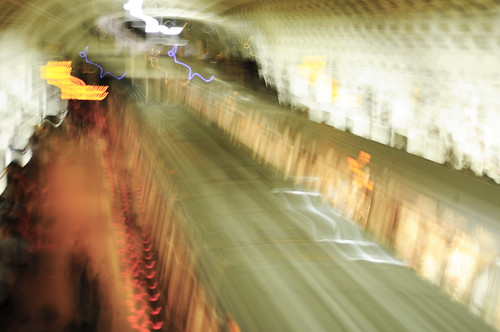
”
courtesy of ‘Chris Rief aka Spodie Odie’
Today in a five hour long hearing, (not including a one hour long lunch break) the NTSB released their findings on the 2009 Red Line crash. Chairwoman Hersman kick off the hearing with opening remarks that highlighted the thoroughness of the report, the importance of its findings and immediate need for WMATA to take action to rectify what Hersman called “WMATA’s anemic safety culture.”
As Tom pointed out earlier today, many of the findings had already been unearthed. NTSB Engineer Payan spent a good length of time both describing and fielding questions about the failures of the Automated Train Operation (ATO) system and the WEE-Z bond sensors that caused the first train to essentially disappear from the track circuitry sensors and made the second train speed up and, tragically, slam into the first train. Prior to the crash, circuit failures like this were happening so often that WMATA employees became desensitized to the alerts and would ignore them. More shocking is that since the crash, WMATA has identified about 290 track circuits capable of this same failure and has not replaced them. No word on if WMATA is currently paying more attention to the alerts.
Another major finding surrounds the 1000-series cars. While it’s widely known that the cars are not-at-all crashworthy when placed at the front or back of a train, WMATA is so late to the game in replacing them, its proposed solution was/is to “belly” the cars, aka: move them to the center of train. However, NTSB findings from a November 2009 West Falls Church Metro Crash proved that bellying does not prevent catastrophic damage to the 1000-series cars. Conclusion: Replace them ASAP and then look to the 2000 and 3000 series because they’re suspect as well.
NTSB’s Board Members latched onto a report finding that the operator of the stationary train had chosen to manually operate the train rather than follow WMATA policy and keep the train on automatic. While not the direct cause of the crash, Board Members continually referenced this fact as strong evidence of WMATA’s and WMATA staff’s systemic lack of respect for safety regulations and operational rules. It’s important to note that since the 2009 Red Line crash, WMATA has implement a manual operation only policy.
After the lunch break, the hearing focused on WMATA’s safety culture. Findings, comments and questions centered around all parties within WMATA as being guilty of either turning a blind eye to safety issues or not installing the appropriate incidence reporting structure or failing to follow up on/solve serious safety problems or concerns. An adequate summary of WMATA’s “safety culture” findings would be: if there is one, no one knows or seems to care about it.
At the end of the hearing, NTSB got to the meat of the report, their 23 recommendations (including removal of the 1000-series cars, strict track circuit testing protocols, etc.) for WMATA and a vow to follow up with WMATA on implementing these recommendations as fast as possible. The preliminary findings and a transcript of the hearing should be available on NTSB.gov shortly. In response to the hearings, WMATA posted a press release on the NTSB hearings, that focuses on their current initiatives to improve Metro’s safety.
All in all, the hearing and report were super thorough, well executed and, as a Metro rider, scary. Before the hearing, I was a rider living in the ignorance is bliss mentality when it came to WMATA. Now that I’ve seen the light, I somewhat wish I could go back down to my cave.
Aside from exposing so many seriously huge gaping holes, the NTSB hearing gave off the almost exasperated tone of “when do things have to get bad enough for things to change!” It almost felt like NTSB was suggesting that shutting down WMATA and starting over might be the only feasible option to fix these organizational flaws. Personally, I don’t know if even a stoppage (and realistically this is not going to happen) and a complete WMATA restructuring would even be drastic enough. Can you seriously fix something like this when it’s so fundamentally broken? A question more apt for the situation would be: is it possible to fix a flat tire without stopping the car?


Pingback: Tweets that mention NTSB Finds Systemic WMATA Safety Issues From Red Line Crash Investigations » We Love DC -- Topsy.com
NTSB wants Metro to remove the 1000 series right now, but Metro continues to refuse making an excuse that they need them. Bellying and fixing them are not the solution. They need at least 700 new railcars, 428 is not enough.
So we are practically forced to take metro with smartbenefits from our employer or pay heavy parking fees and sit in traffic and now we learn how much we are risking in our safety. To make these changes, what will the fee increase have to be? If it is too high to park and ride versus driving and parking, metro ridership could be way down increasing traffic. Again, what is the benefit of taking metro when it costs about the same as driving and has all of these other unpleasantries.
Pingback: NTSB criticizes Washington Metro over 2009 crash – CNN | The Fresno News